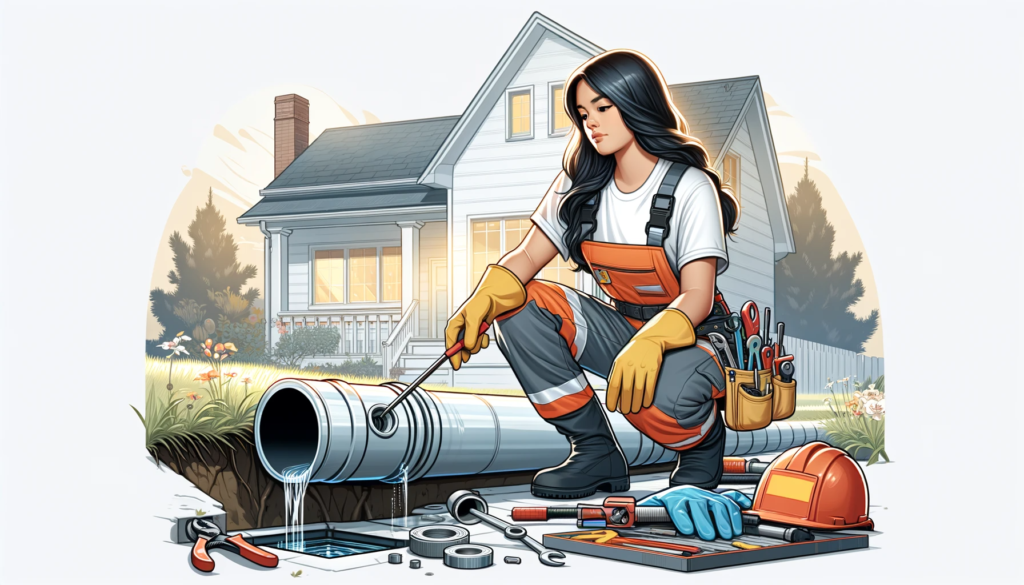Ensuring Health and Safety in Drain Maintenance: A Guide for Homeowners and Professionals

As a homeowner who prides themselves on maintaining the integrity of every aspect of their household, or as a professional in the field, the significance of health and safety in drain maintenance cannot be overstated. Beyond just ensuring the smooth operation of your drainage system, it is about safeguarding your well-being and that of others involved. In this comprehensive guide, we’ll explore the crucial considerations and precautions necessary to keep safety at the forefront of drain maintenance efforts.
Introduction to Drain Health and Safety
Drain maintenance is not merely a matter of keeping water flowing. It’s about understanding the intricate balance between functionality and safety. Common hazards, such as exposure to harmful bacteria or the risk of injury, lurk in overlooked corners. Recognizing these risks is the first step towards a safer maintenance routine. With a slew of potential threats, it’s essential to equip oneself with the knowledge and tools necessary to mitigate them effectively.
Key Takeaways:
| Aspect | Detail |
|---|---|
| Safety Importance | Paramount to maintenance routines |
| Hazard Awareness | Key in preventing accidents and health issues |
| Knowledge Application | Empowers safe and effective drain maintenance |
Following these principles is not just about compliance; it’s about peace of mind that comes from knowing you’re doing things the right way. Let’s proceed by delving into the types of hazards you may encounter.
Understanding Drain Hazards
When considering drain maintenance, many neglect the fact that the work environment can be hostile. Standing water or built-up debris can turn into a breeding ground for bacteria and pathogens. Without the right precautions, one’s health could be jeopardized, not to mention the physical risks that come with handling heavy equipment or working in confined spaces. It’s imperative to be mindful of these dangers to ensure our efforts to maintain our drains do not come at an unreasonable cost to our health.
Health Implications Table:
| Hazard Type | Potential Health Concerns |
|---|---|
| Biological Exposure | Illness from bacteria, parasites, or viruses |
| Physical Strain | Injuries from heavy lifting or awkward positioning |
| Chemical Contact | Burns or respiratory issues from cleaning agents |
Comprehending the health implications is a pivotal point of our conversation. This understanding ensures the well-being of everyone involved and reduces the likelihood of accidents and the spread of illnesses. With this knowledge at hand, we turn our attention to the arsenal we should have for such tasks—our safety equipment.
Essential Safety Equipment for Drain Work
When it comes to handling drains, few things are as critical as the Personal Protective Equipment (PPE) you wear. Gloves, goggles, and even respirators might form part of your drain maintenance garb, protecting you from the immediate dangers presented by the task at hand. Moreover, boots that resist slips and supportive garments can be the very thing that stands between a safe maintenance session and a trip to the hospital.
PPE Checklist:
- Gloves: Protect against cuts and contaminants
- Goggles: Shield eyes from splashes
- Respirators: Filter out harmful gases and particles
- Non-slip boots: Prevent falls and injuries
- Supportive garments: Offer support and protect the body
Best practices for equipment usage involve regular inspection and maintenance to ensure that when the time comes, your gear is as ready as you are. Forgetting this critical step can compromise the very safety we seek to establish. Next, we will address health and safety standards and their role in drain maintenance.
Adhering to Health and Safety Standards
Standards set by organizations like OSHA, the Occupational Safety and Health Administration, are not just guidelines; they are the bare minimum requirements for ensuring a safe work environment. Compliance with such standards is non-negotiable and serves as a bedrock for establishing safe practices in drain maintenance. Whether it’s the proper labeling of chemicals or the procedures for safely entering a confined space, these regulations are there to protect you.
Standards Compliance Importance:
- Reduces accidents: By following protocols, the risk of workplace injuries decreases.
- Ensures accountability: Compliance is proof of commitment to safety.
- Improves outcomes: Safe work environments lead to more efficient and effective maintenance work.
Ignoring these standards can have severe implications, from legal repercussions to personal harm. Therefore, it pays to be not just familiar, but proficient in the standards that govern our work. Additionally, staying abreast of any changes or updates to safety regulations ensures ongoing compliance and safety.
Drainage System Hygiene Protocols
Maintaining a clean and hygienic drainage system is not only about operational efficiency; it’s about preventing the spread of disease and, ultimately, protecting human health. Establishing protocols for drain hygiene can seem daunting, but it’s nothing a structured approach can’t tackle.
Here’s a quick list of Hygiene Protocols you should follow:
- Regular Cleaning: Schedule regular cleaning sessions to prevent build-up.
- Proper Disposal: Ensure waste is disposed of correctly to minimize contamination.
- Use of Sanitizers: Apply appropriate cleaning agents to keep areas disinfected.
By adhering to such hygiene protocols, you’ll not only keep your drains functioning optimally but will also contribute to a healthier environment.
Risk Assessment and Prevention Strategies
Before any maintenance activity, performing a risk assessment is crucial. This preventative approach allows you to identify potential hazards and implement strategies to avoid them. As part of this assessment, consider factors such as the layout of the drainage system, the type of equipment required, and potential contact with hazardous substances.
Here are some steps for a thorough Risk Assessment:
- Evaluate the workspace for safety hazards.
- Determine the likelihood of occurrences and their potential impact.
- Decide on preventive measures and protective gear.
By anticipating and mitigating risks, not only do you ensure the safety of all involved, but you also streamline the maintenance process, making it more efficient and effective.
Training and Education for Safe Drain Maintenance
Equipping oneself with the proper knowledge and skills is just as important as having the right tools. Training provides the foundation for safe working practices, whether it’s handling equipment correctly or knowing how to respond to emergencies. Resources for education and training are widely available and often necessary for compliance with regulatory bodies.
Training Benefits:
- Enhances safety knowledge and skills.
- Reduces the likelihood of accidents.
- Ensures up-to-date compliance with health and safety regulations.
Investing in continuous learning and training is not just a professional responsibility; it is an ethical one, ensuring that everyone returns home safely after a job well done.
Common Drain Problems and Safe Solutions
No matter how well you maintain your drains, issues can arise. Being able to identify and safely address common drain problems is a critical skill for both homeowners and professionals. From simple clogs to more complex sewer line issues, the safety-first approach should always be at the forefront of your solution seeking.
When dealing with drain issues, consider consulting our detailed guide on common drain problems. Here, you’ll gain insights into fixes that don’t compromise on safety or quality.
Drainage System Types and Specific Safety Considerations
Different types of home drainage systems may require unique safety precautions. For a comprehensive overview of these systems and tailored safety tips, visit our in-depth article on types of home drainage systems. The more informed you are about the specifics of your system, the better equipped you’ll be to handle it safely.
DIY Drain Installation: Ensuring Your Safety
DIY projects can be rewarding, but they can also carry risks, especially when it comes to drain installation. Ensure you’re aware of the safety measures necessary to protect yourself. Our guide on DIY drain installation provides valuable tips to help you complete your project without compromising on safety.
Remember, when it comes to drains, cutting corners can lead to greater hazards down the line. Always prioritize safety, even in seemingly simple DIY scenarios.
Eco-Friendly Solutions and Safety
In an era of environmental consciousness, applying eco-friendly solutions to drainage maintenance isn’t just good for the planet—it can also contribute to safety. Using non-toxic cleaning agents, for example, not only protects the environment but also reduces the risk of exposure to harmful chemicals.
Explore various green practices in our article about eco-friendly drain solutions, which details how you can maintain your drains responsibly while keeping safety in mind.
Emergency Drainage: Quick Safety Tips
Drainage emergencies can catch even the most diligent homeowner off guard. During these crises, the focus on safety becomes even more important. For immediate and safe actions to take in an emergency scenario, consider our resourceful article on emergency drainage solutions. These tips can help you navigate the urgency without neglecting the critical aspect of safety.
Quick, decisive action is necessary but never at the expense of your health or safety. Keep these guidelines handy to ensure a well-prepared response when the unexpected occurs.
Strategic Landscaping for Safe Drainage
Believe it or not, landscaping can influence the safety and efficiency of your drainage system. Strategic planting and contouring of land can significantly impact water flow and drainage. To delve deeper into how landscaping can serve as a safety measure and enhance drainage, check out our breakdown on landscaping and drainage.
Proper landscaping choices can prevent water accumulation, minimizing slip hazards and reducing the risk of water damage—a win for safety and functionality.
Seasonal Drainage Maintenance and Safety
With the changing seasons, drainage maintenance needs can fluctuate significantly. It’s important to adapt your safety measures accordingly. For instance, winter may call for precautions against frostbite while working on outdoor drains, whereas the rains of spring necessitate care against slippery conditions.
For a season-by-season guide on maintaining your drainage system, along with safety tips, visit our informative piece on seasonal drainage care.
Seasonal Safety Tips:
- Winter: Insulate pipes to prevent freezing and wear appropriate gear for the cold.
- Spring: Ensure proper footing on wet surfaces to prevent slips.
- Summer: Stay hydrated and protect against heatstroke while working in high temperatures.
- Fall: Clear gutters and downspouts regularly to prevent blockages and potential overflows.
By being prepared for each season’s specific challenges, you ensure the health and safety of not only your drainage system but also everyone involved in its upkeep.
Conclusion: Prioritizing Health and Safety
As we wrap up this guide, remember that prioritizing health and safety in drain maintenance is paramount. It’s a task that requires diligence, preparation, and a commitment to following best practices. Whether you are a homeowner taking on the challenge or a seasoned professional, your awareness and actions can help maintain the resilience and efficiency of the drainage systems we rely on, while safeguarding the well-being of all.
By integrating the correct safety protocols, regularly training and educating oneself, and adhering to eco-friendly and seasonally appropriate practices, we contribute to a safer, healthier living and working environment. Consider revisiting the various areas of this guide to refresh your knowledge and stay on top of safety trends in the world of drainage maintenance.
Final Health and Safety Checklist:
- Assess and mitigate risks before beginning drain maintenance.
- Equip yourself with the correct PPE and maintain it properly.
- Stay informed on health and safety standards and regulations.
- Practice regular hygiene protocols for your drainage system.
- Seek continuous training to stay adept in safe maintenance methods.
Your health and the safety of those around you depend on these practices, making them not just recommendations, but necessities. Remember, effective drain maintenance is about more than just the technicalities—it’s about performing responsibly, with safety at the forefront, every single day.
FAQ:
- What are the risks of drain maintenance?
- Biological exposure, physical strain, and chemical contact are some of the risks that come with drain maintenance.
- Why is it important to follow OSHA regulations?
- OSHA regulations are designed to minimize workplace injuries and ensure a safe working environment.
- Can eco-friendly drain solutions also ensure safety?
- Yes, eco-friendly solutions can reduce exposure to harmful chemicals, benefiting both the environment and personal safety.




